Bulletin – September 2015 Australian Economy Lower Bulk Commodity Prices and Their Effect on Economic Activity
- Download the article 251KB
Abstract
Recent declines in bulk commodity prices have reduced the growth of household income, company profits and government revenues. The declines have been associated with a contraction in mining investment and, by lowering the growth of aggregate demand, have restrained non-mining business investment. At the same time, a number of factors are helping to offset the effects of declining commodity prices. These include accommodative monetary policy and the depreciation of the exchange rate. Also, after saving some of the mining boom proceeds, households appear to be reducing their rates of saving to maintain consumption.
Introduction
Since 2011, there have been large declines in global prices for so-called ‘bulk’ commodities, which are iron ore and coking coal (both used in steel production), and thermal coal (used in energy production) (Graph 1). The declines follow large price increases over the 2000s, when growth in global demand for steel and energy, particularly from China, exceeded growth of bulk commodity supply. In time, these higher prices led to a marked expansion of capacity and production, including in Australia. Prices were expected to decline as production increased, but the sizes of the declines have been larger than most forecasters had anticipated.
The combination of higher prices and increased domestic production has at times seen bulk commodities account for over a third of Australia's export revenue in recent years. This large share means that the recent price declines have significantly reduced growth of Australia's export revenues and, through various channels discussed in this article, have slowed the growth of economic activity. The Australian dollar has depreciated, partly in response to the bulk commodity price declines, and monetary policy has become more accommodative, both of which have dampened the effect of lower commodity prices on economic activity.
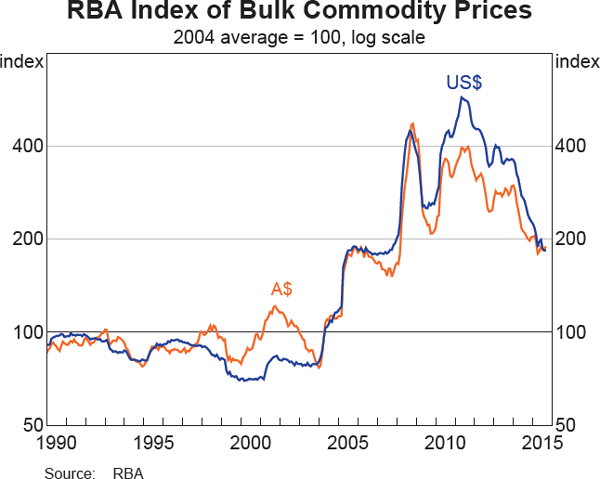
The first section of this article describes the main channels through which lower bulk commodity prices affect the Australian economy, including the offsetting effects of the exchange rate depreciation. It organises the channels into those affecting business investment, net exports, public demand and household consumption – the main expenditure components of GDP. To simplify the discussion it does not include the impacts of the monetary policy response.[1]
Accurately estimating the importance of the channels is challenging, partly because the expenditure components interact with each other and with other economic developments. Rees, Smith and Hall (2015) estimate a model of the Australian economy that is useful for this task and can incorporate the effects of monetary policy. The key results are summarised in the second section of this article. A similar exercise has been conducted by Tulip (2014), using a different model, with a focus on the effects of rising commodity prices during the 2000s. Although our focus is on the period of falling commodity prices, our estimates for the period of rising prices are quantitatively similar to those in Tulip (2014).[2]
Describing the Main Transmission Channels
Business investment
The cycles in bulk commodity prices and mining investment since the mid 2000s have been closely linked. The initial expansion of mining capacity in response to the rise in commodity prices required large increases in spending on construction, machinery and equipment. As global production expanded to a level commensurate with the increase in demand, prices eventually declined and incentives for further investment diminished. After making an important contribution to Australian GDP growth as commodity prices rose, mining investment has subtracted from growth since the latter part of 2012 (Graph 2).

The companies mining bulk commodities in Australia had anticipated that prices would decline and they had already limited commitments for new investment spending before most of the recent price declines occurred. However, as the declines in commodity prices and mining company profits have been larger than was anticipated, mining investment may have declined by more than would otherwise have been the case. Information from the Bank's liaison program suggests that many producers have responded by reducing spending targeted at maintaining their mines and have embarked on other cost-cutting measures.
For non-mining business investment, the effect of the declines in bulk commodity prices operate partly through the associated exchange rate depreciation. Working in one direction, the lower exchange rate has made investment spending relatively more expensive because Australia imports many of its capital goods from overseas. Working in the other direction, the depreciation has improved demand conditions for businesses that produce tradable goods and services via an improvement in international competitiveness. Domestic demand and labour market conditions also matter for business investment, so the aggregate impact of the decline in commodity prices depends partly on the channels involving the other expenditure components. On the whole, even if the net effect of the depreciation is to stimulate an expansion of non-mining business investment, this effect is partly offset by the contractionary effects of lower commodity prices on other components of domestic demand.
Net exports
The increase in mining capacity triggered by the initial rise in commodity prices has led to strong growth in the volume of resource exports, particularly in recent years (Graph 3). The subsequent price declines have so far had little impact on export volumes because most Australian production has remained profitable. There have been some reports of smaller, less profitable mines closing down over the past year, particularly in the coal sector. Further closures are possible if prices remain at current levels for an extended period or decline further. While exports of bulk commodities are expected to continue to grow over the next couple of years as additional capacity comes on line, the pace of growth is expected to moderate.
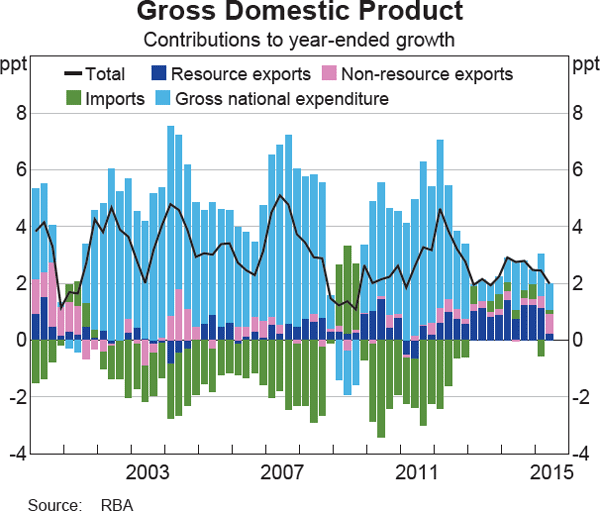
Non-resource export volumes are being supported by the lower exchange rate, through the associated improvement to competitiveness. Service exports have clearly responded, including in the sectors of tourism, education and business services. The overall pick-up of total non-resource exports has been limited in the current episode though, as manufactured exports have remained subdued and have not responded to the exchange rate depreciation by as much as historical relationships would suggest.
On the import side, volumes initially rose as commodity prices increased, in line with the pick-up in demand for mining capital goods and the appreciation of the exchange rate. As commodity prices have unwound, the reverse has occurred. In particular, imports of capital goods and services have declined of late.
Public demand
The Australian Government and some state governments collect significant revenues from the production and sale of bulk commodities. For the state governments – particularly Queensland and Western Australia, which have large endowments of bulk commodities – the revenues take the form of royalties, tied directly to the market value of production. For the Australian Government, the revenues mostly take the form of company taxes, tied indirectly to the market value of production via mining company profits. Movements in commodity prices may also influence capital gains and personal income tax receipts through their effect on the share prices of mining firms and employee wages.
The links to the value of resource production mean that government revenues were boosted as bulk commodity prices were high and rising, while more recently falling prices have been weighing on government revenues. For instance, the latest Australian Government budget estimated that recent declines in the actual and projected iron ore price reduced expected tax receipts by $20 billion over the four years to 2017/18. This compares with a total projected cash deficit of $116 billion over that time.
In principle, governments can respond to the revenue declines in several ways. One option is to reduce public demand, which captures components of government expenditure that contribute directly to economic activity. Alternatively, governments can reduce net transfer payments to households and business, in which case the economic impact would occur through those sectors. Governments can also absorb the lower revenues by borrowing more (or saving less), deferring some of the economic impact to a later date.
Although it is difficult to identify separately the governments' responses to the cycle in bulk commodity prices in the current episode, they appear to have chosen a mix of the options. For the Australian Government, for instance, recent budgets have downgraded projected growth of public demand and new policies have reduced net transfers to households. The Australian Government has also increased projected borrowing.[3]
Household expenditure
The bulk commodity prices cycle has also had important implications for household expenditure, primarily through its effect on real household disposable income. For instance, Tulip (2014) estimates that the mining boom boosted real household disposable income by around 13 per cent at its peak. Lately some of that has been unwinding, contributing to relatively low income growth by historical standards (Graph 4). While the unwinding has occurred partly through the reductions in net government transfer payments, other channels have also been important.
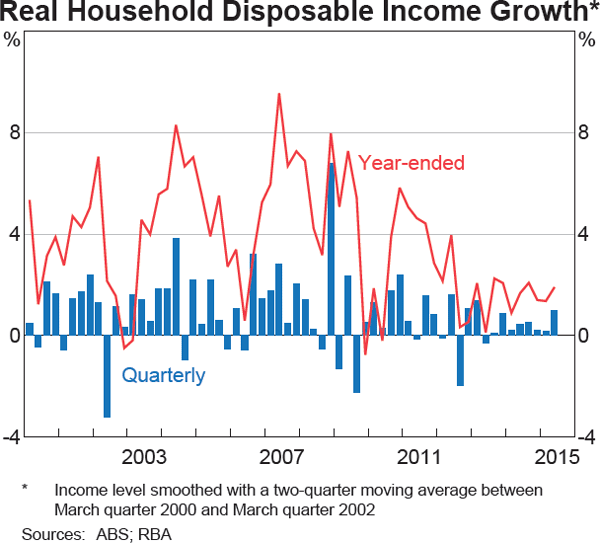
One of the key channels is labour income. The pressure for firms in the mining industry to improve efficiency has caused them to rein in labour costs. In addition to that effect, the transition from the investment to the production phase of the mining boom has been reducing the amount of labour required for resource and resource-related activity. The direct effects of a reduction in employment in the resource sector are likely to be small because mining accounts for just 2 per cent of total employment. However, it could have broader effects due to spillovers to other industries. The Bank's liaison suggests that broader cost-cutting initiatives in the mining industry have placed pressure on the margins of businesses that supply goods and services to the mining industry, which have sought to reduce their own labour and supplier costs as a result. According to estimates by Rayner and Bishop (2013), in 2011/12 these businesses accounted for more than twice as much employment as the mining industry. Recent work by Jacobs and Rush (2015) has also shown that even across industries that have little relation to mining, growth of labour costs has slowed noticeably from the time that bulk commodity prices started to fall, suggesting that low wage growth has had a more general role in the economy's adjustment process.
Another channel is mining company dividends, which are paid out of company profits. The effect on domestically distributed dividends is smaller than the decline in company profits because foreign ownership of mining companies is high. Mining companies also tend to commit to maintaining or increasing dividend payments over time, which smooths dividend payments through changes in commodity prices, particularly anticipated ones. While some mining companies have reduced their dividends recently, aggregate industry dividend payments have increased in recent years (Graph 5).
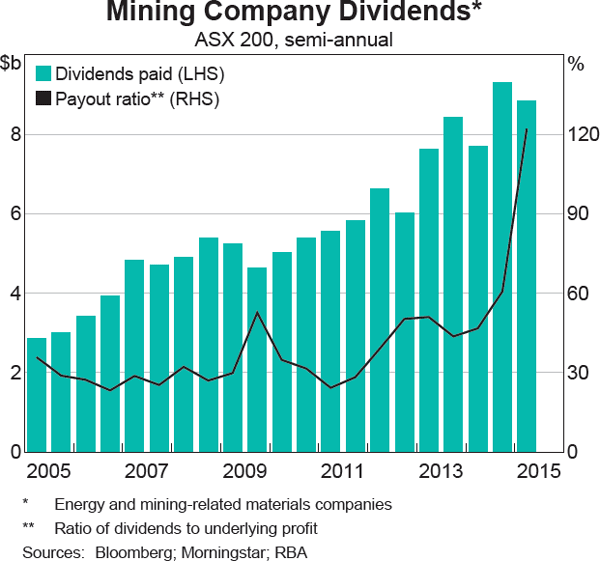
Ultimately, how changes to household income affect consumption depends on whether the changes are perceived to be persistent or temporary. Households typically prefer to smooth their consumption over time, so income changes that are perceived to be temporary often result in larger changes to saving than to consumption. Recent research has found that Australian households, like the mining companies, have, in aggregate, behaved as if they perceived the initial boost to real incomes from the bulk commodity price increases as largely temporary.[4] This behaviour can account for some of the gradual decline in the household saving ratio that has been observed over recent years, which has dampened the effect of slower income growth on consumption growth (Graph 6).
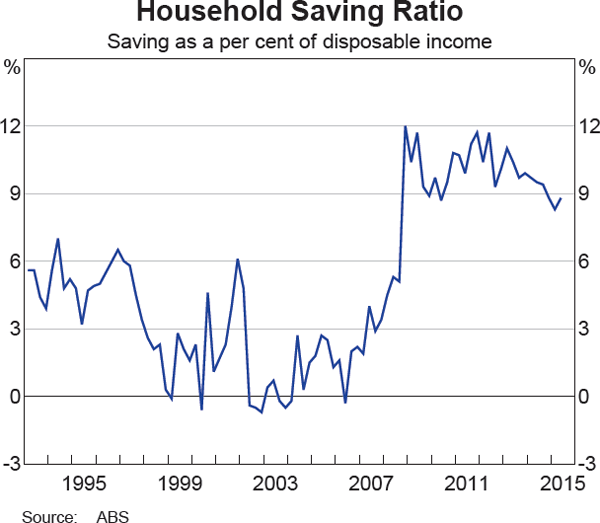
Modelling the Impacts
To gauge the relative importance of the channels described above, we simulate the effect of lower bulk commodity prices using the multi-sector model of the Australian economy described in Rees et al (2015). Using a model allows us to explore the effects of commodity price changes while controlling for other economic developments and to account for simultaneous interactions between different households and businesses. It also allows us to explore how the effects play out across industries (the so-called ‘production side’ of the economy), using the three broad industry classifications: the mining sector; the non-mining tradable sector; and the nontradable sector. The model makes a number of simplifying assumptions, including that public demand does not react to changes in commodity prices. The model is calibrated to fit Australian data and generates results with strong qualitative parallels to the channels described above.
To generate our results we impose a path of commodity prices that roughly matches the changes in the RBA's Index of Commodity Prices (ICP) since 2003 (Graph 7)[5]. At each point during the commodity price boom, households and firms in the model expected commodity prices to decrease in the future. In this sense, the boom was unanticipated.[6] However, the fall in commodity prices was anticipated. For the purposes of the scenario, the model assumes that commodity prices continue to decline until the end of 2018, although they remain considerably above their pre-2003 levels. The extension to 2018 illustrates the transition of the economy to an environment of lower commodity prices, which plays out gradually over several years. This extension should not be interpreted as a forecast. We show our results relative to what the model would have predicted if commodity prices had remained stable since 2003.
The commodity price boom is estimated to have raised the level of GDP, relative to the no-boom baseline, by around 4 per cent at the peak of the boom in 2011 (Graph 8).[7] As commodity prices fall, the model indicates that output grows at a below-average pace and eventually reverts to its no-boom baseline.
Graph 8 also shows the contributions of the expenditure components of GDP to changes in the level of output. Consistent with the actual pattern of investment in recent years, mining-related investment falls sharply after the peak in commodity prices (Graph 9). This is only partially offset by increased investment in the other sectors of the economy.
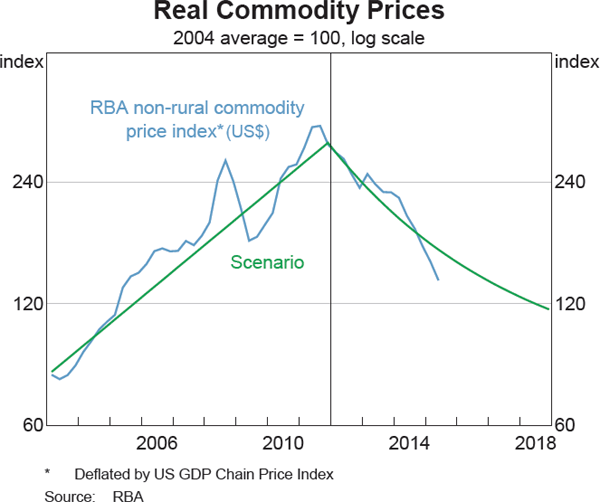
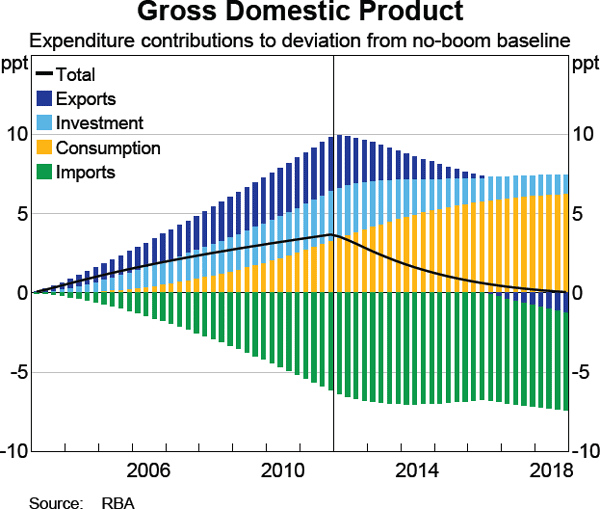
Export volumes decline, because when commodity prices fall the model predicts that some marginal mining projects become unprofitable. The associated resource export declines are partly offset by a pick-up in non-resource exports, which benefit from a depreciation of the exchange rate (see below). As so few mining projects have to date become unprofitable, the model seems to overstate the response of resource exports. Indeed, resource exports have increased strongly in recent times, because of lags from investment to production. In the model, imports are expected to decline slightly in response to the lower commodity prices, reflecting developments in the other expenditure components and the exchange rate depreciation.

The model suggests that consumption continues to expand at an above-average pace even as commodity prices fall, because households draw down on the savings that they accumulated during the period of rising commodity prices. This prediction accords with the rise in the household saving ratio from 2006 and the decline in the household saving ratio observed in recent years, although aggregate consumption growth has been more subdued than the model results would imply. This discrepancy could reflect the fact that household consumption, like the other expenditure components is, in practice, affected by many factors besides falling commodity prices that are not modelled in this scenario. For example, as illustrated in Jacobs and Rush (2015), wages growth has been particularly slow over the past few years, even after accounting for changes in the terms of trade.
Consistent with recent patterns, the aggregate industry breakdown in the model suggests that mining sector output remains at an elevated level relative to baseline even after commodity prices start to fall (Graph 10). This reflects the substantial increase in mining investment that occurs during the boom in commodity prices, which expands the productive capacity of the mining industry. The model suggests that output in the non-tradable sector gradually moves back towards its baseline level, largely due to a fall in demand for non-traded goods and services by mining firms as they start to wind back on investment in new projects.
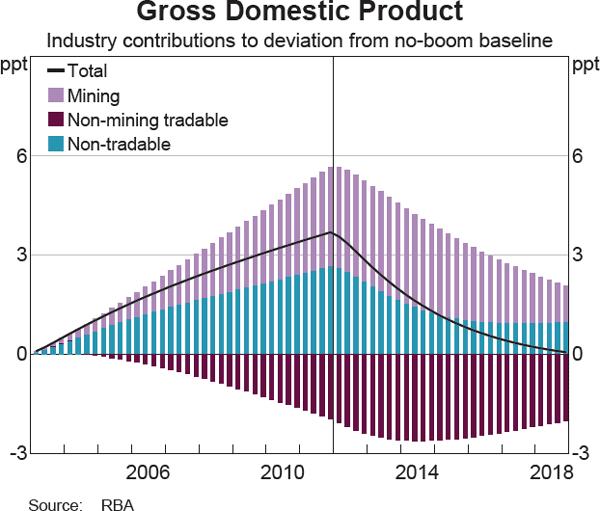
During the commodity price boom, the expansion of the mining and non-traded sectors is partly accommodated by slower growth in the non-mining tradable sector. This accommodation allows labour and capital to move to the expanding parts of the economy and helps to contain the inflationary consequences of the boom. After commodity prices start to fall, the model suggests that it takes several years for the non-mining tradable sector to start to recover, much as has been observed over recent years. This protracted nature of the recovery may reflect the fact that the commodity price boom coincided with a sustained period of relatively low investment in this sector, which lowers its productive capacity. Moreover, even though the exchange rate depreciates after the boom, it is estimated to remain above pre-boom levels in line with the assumption about commodity prices.
The model suggests that falling commodity prices will typically lead to a period of below-average economic growth, but, consistent with recent data, it does not predict a sharp contraction in activity. A number of factors help to mitigate the adverse economic consequences of lower commodity prices. One of these is the depreciation of the exchange rate, which, in time, helps to support a recovery in the non-mining tradable sector (Graph 11). Monetary policy also helps to support the economy through the commodity price cycle. During a commodity price boom, monetary policy is tighter than otherwise, in order to mitigate the inflationary consequences of rapidly rising domestic income. Once commodity prices start to fall, monetary policy helps to support economic activity, especially in the non-mining sectors, which include the most interest-sensitive parts of the economy. As with the exchange rate, it takes time for accommodative monetary policy to translate into a pick-up in the pace of economic activity.

Conclusion
Bulk commodity prices have declined substantially in recent years, along with a range of other commodity prices. The declines have reduced the pace of growth in household income, company profits and government revenue, have been accompanied by a contraction in mining investment expenditure and, by lowering the growth of aggregate demand, have restrained non-mining business investment.
At the same time, a number of factors are helping to offset the effects of falling commodity prices. These include the depreciation of the exchange rate, which is helping to stimulate growth of net exports. Accommodative monetary policy is also assisting the transition, through a number of channels. And, having apparently saved some of the proceeds of the mining boom, households seem to be lowering their rates of saving to maintain consumption as commodity prices fall.
Footnotes
The authors are from Economic Group. [*]
The effects of monetary policy on the economy are discussed by Kent (2015). [1]
Implications of the mining boom, including its impact on the labour market, are also discussed in detail in Connolly and Orsmond (2011). [2]
Further details are available in Australian Government (2015). [3]
The research includes Rees (2013) and Kulish and Rees (2015). [4]
The ICP is an indicator of the average prices received by Australian commodity exporters, with commodities weighted by their relative importance in total commodity export earnings. The weight of bulk commodities in the index is currently around 58 per cent, although the ICP also includes rural commodities, base metals and other resources exported by Australia. The broader index is used here because it corresponds to the concept of commodity prices in the model. [5]
This is consistent with the pattern of forecast errors during the commodity price boom documented in Plumb, Kent and Bishop (2013). [6]
In all graphs, the vertical line denotes the peak in commodity prices. This is somewhat smaller than the estimate of 6 per cent reported in Downes et al (2014). It is not unusual for different macroeconomic models to provide slightly different estimates. Although there are several reasons for the difference, one factor may be that Downes et al define the mining boom to also include a large increase in investment, over and above that explained by high commodity prices. [7]
References
Australian Government (2015), ‘Budget Strategy and Outlook 2015-16’, in Budget Paper No. 1, 2015/16 Australian Government Budget, Commonwealth of Australia, Canberra.
Connolly E and D Orsmond (2011), ‘The Mining Industry: From bust to boom’, RBA Research Discussion Paper No 2011-08.
Downes P, K Hanslow and P Tulip (2014), ‘The Effect of the Mining Boom on the Australian Economy’, RBA Research Discussion Paper No 2014-08.
Jacobs D and A Rush (2015), ‘Why Is Wage Growth So Low?’, RBA Bulletin, June, pp 9–18.
Kent C (2015), ‘Monetary Policy Transmission: What's Known and What's Changed’, Public Lecture at the Australian National University, Canberra, 15 June.
Kulish M and D Rees (2015), ‘Unprecedented Changes in the Terms of Trade’, RBA Research Discussion Paper No 2015-11.
Plumb M, C Kent and J Bishop (2013), ‘Implications for the Australian Economy of Strong Growth in Asia’, RBA Research Discussion Paper No 2013-03.
Rayner V and J Bishop (2013), ‘Industry Dimensions of the Resource Boom: An Input-Output Analysis’, RBA Research Discussion Paper No 2013-02.
Rees D, P Smith and J Hall (2015), ‘A Multi-Sector Model of the Australian Economy’, RBA Research Discussion Paper No 2015-07.
Rees D (2013), ‘Terms of Trade Shocks and Incomplete Information’, RBA Research Discussion Paper No 2013-09.
Tulip P (2014), ‘The Effect of the Mining Boom on the Australian Economy’, RBA Bulletin, December, pp 17–22.